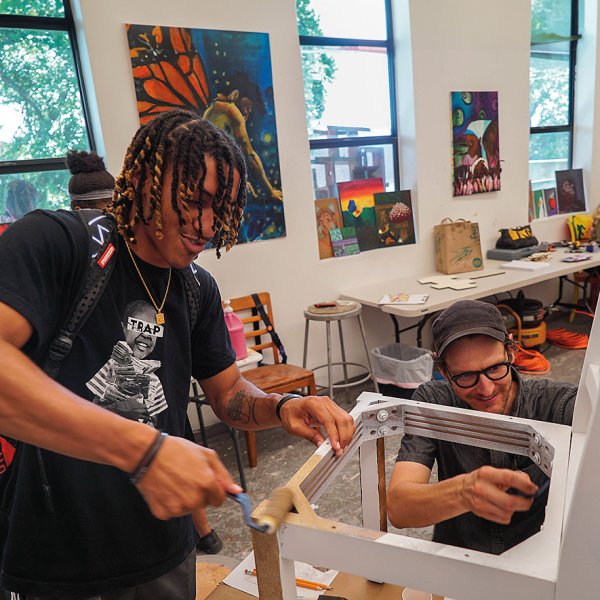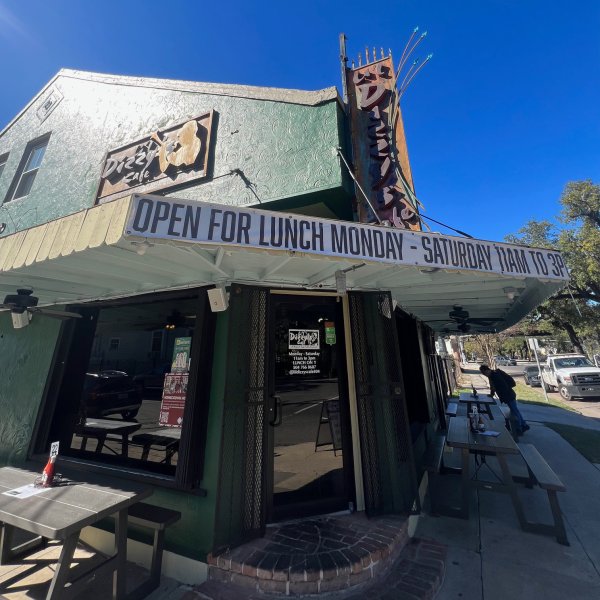The Scene: Places and Spaces
The Scene: Places and Spaces
Where to Buy Supplies
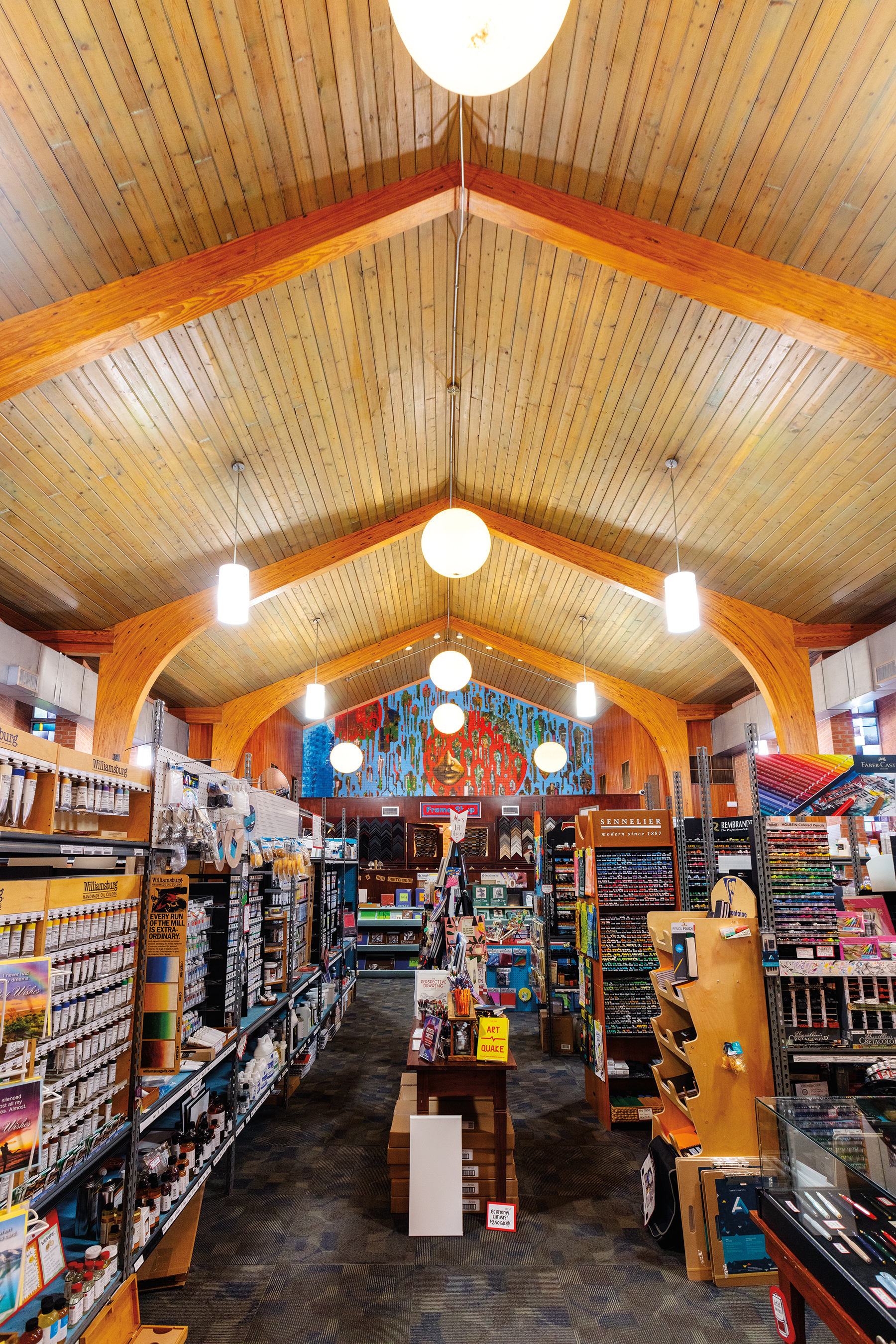
“Most of us get our clay from Alligator Clay Company in Baton Rouge,” says MaPó Kinnord. The company manufactures and distributes over 30 kinds of moist clay.
Charles DuVernay says he gathers suit-making materials—whether canvas, feathers, sequins, or beads—at “Miss Helen’s,” referring to Broadway Bound Costumes on Canal Street, which was run for decades by the late Helen Koenig.
“The Green Project is an incredible resource,” says Hannah Chalew. “It’s a salvage store for construction materials and a great place to shop and support.”
“That’s my go-to,” says DuVernay of Jefferson Variety Stores, located just outside New Orleans in Jefferson. The store, an institution for locals, specializes in costume fabric, sequin and rhinestone appliques, and beads.
“Mo’s Art Supply & Framing is an art supply company on Bienville Street, close to my house,” says Kinnord. “They have a lot. I go there for paints and all kinds of other stuff.” Chalew agrees, adding, “If I really need a specific art material, Mo’s Art Supply is a superb local art store in the city.” Declares Pippin Frisbie-Calder, “They are the best in NOLA!”
The motto for the shop NOLA Craft Culture is, “It’s not a hobby, it’s a way of life.” DuVernay, who calls this his “exclusive shop,” couldn’t agree more. “They’re gonna have stuff that nobody else is gonna have.”
“I strive to make my studio practice as fossil-free as possible, so most of my materials are found or foraged,” says Chalew. “For the ink that I make, I gather oak galls below local oak trees around the city.” Still, she has go-to spots for supplies that can’t be gleaned. “When I need metal, I head to Poland Scrap Metal,” a scrapyard on Poland Avenue also favored by Frisbie-Calder.
“I work a lot with reclaimed sinker cypress that I source from the swamps surrounding New Orleans,” says Holdren. “I buy from guys who go out and literally get in the mud and dig these ancient logs out. Riverside Lumber has an incredible selection of rare woods and reclaimed local products, too.”
Museums
George & Leah McKenna Museum of African American Art collects, interprets, and preserves “the visual aesthetic of people of African descent in North America and beyond.”
The Historic New Orleans Collection is a museum, research center, and publisher dedicated to preserving the history and culture of New Orleans and the Gulf South. Spread over three campuses, the collection features restored historic buildings and the French Quarter Galleries.
Founded in 1976, the Los Isleños Heritage and Cultural Society of St. Bernard is housed in the Los Isleños Museum Complex in St. Bernard Parish. The society’s mission is to preserve the folklore, history, language, music, and traditions of Canary Islanders in New Orleans.
To be steeped in the city’s musical history, visit the New Orleans Jazz Museum, which boasts a large collection of memorabilia, sheet music, clothing, and handmade instruments, such as a one-string guitar from 1915 and an Old Peach cigar box violin from around 1894. Some highlights include Fats Domino’s white Steinway piano, refurbished after Hurricane Katrina souped his home with 10 feet of water, and a Lyon & Healy cornet played by a young Louis Armstrong. The historic French Market, which covers five blocks and features everything from alligator heads to handcrafts to beverages and food, is located just behind the museum.
New Orleans Museum of Art, the city’s oldest fine art institution, opened in 1911 with just nine pieces. Today, its permanent collection encompasses nearly 50,000 works, including glass, textiles, and decorative arts. Don’t miss the impressive Sydney and Walda Besthoff Sculpture Garden, which occupies more than 11 acres in City Park adjacent to the museum.
Established in 1999, the Ogden Museum of Southern Art holds an expansive collection of Southern art and is lauded for its exhibitions, public events, and educational programs that examine not only visual art, but music, literature, and culinary traditions in order “to provide a comprehensive story of the South.”
Artists’ Spaces
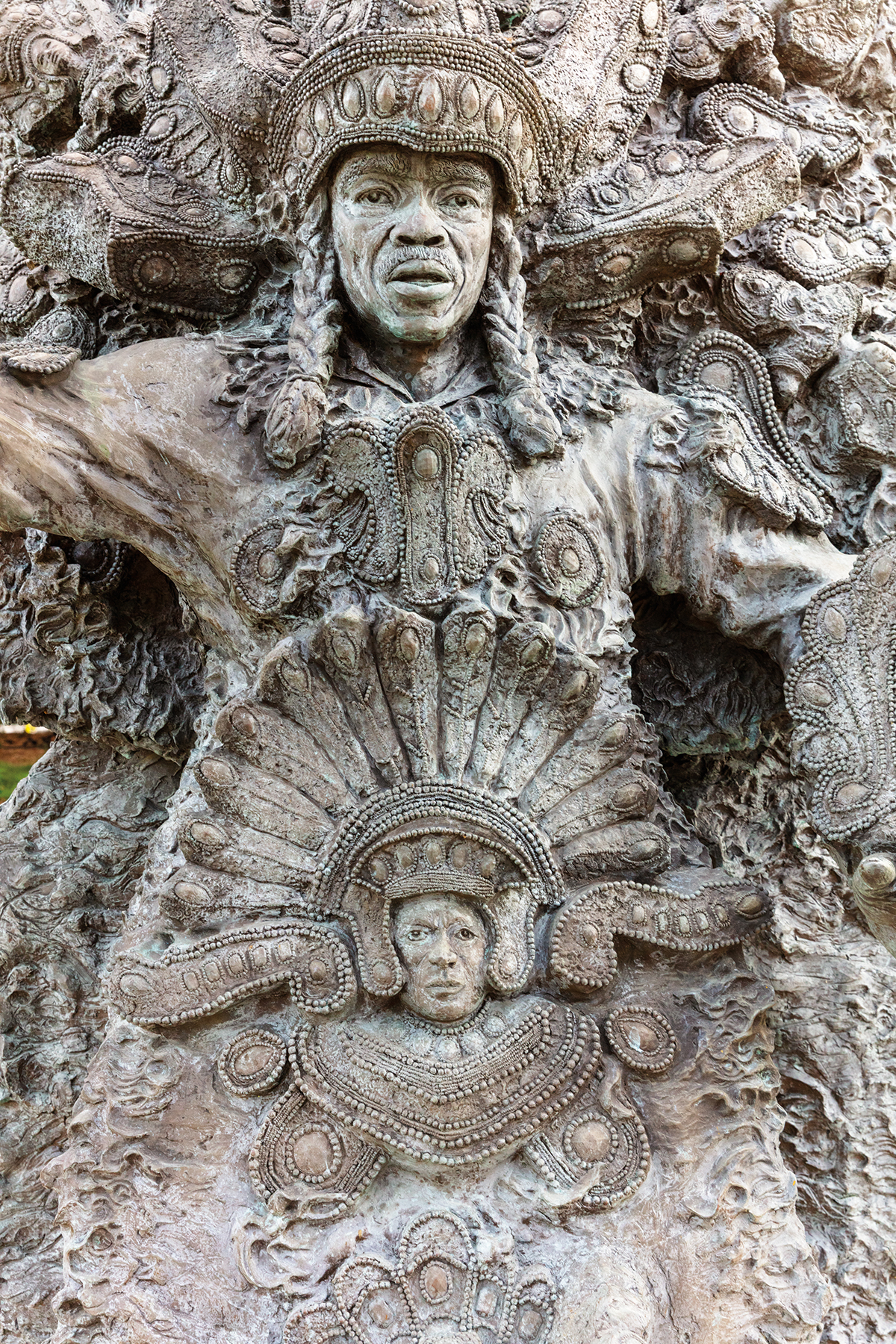
For a quarter century, Ashé Cultural Arts Center has provided programming and support to foster “human, community, and economic development” among the African diaspora in New Orleans. With 10,000 square feet of gallery space and 20,000 square feet of performance space, the arts center produces more than 350 music, theater, dance, spoken word, and multidisciplinary events per year.
The Creative Alliance of New Orleans supports artists, cultural changemakers, and the overall revitalization of the city through training, education, and informational programming.
Launched in 2015 by the Joan Mitchell Foundation, which supports visual artists, the Joan Mitchell Center hosts residencies on its two-acre New Orleans campus.
The 31-acre Louis Armstrong Park, located in the Tremé neighborhood, is full of stunning public art, including the bronze sculpture of Allison Big Chief “Tootie” Montana by local sculptor Sheleen Jones. The park is home to historic Congo Square, where enslaved Africans and free people of color gathered to dance, sing, and play music—practices that influenced the development of jazz.
Visual artist Willie Birch created the Old Prieur Community Memory Garden, a small garden in the heart of the 7th Ward—on the corner of O’Reilly and Old Prieur Streets—that provides greens and flowers for neighbors, alongside sculpture and other artwork.
A Studio in the Woods aims to foster creative responses to thorny challenges like climate change by providing retreats to artists, scholars, and the public in a forest on the Mississippi River.
Schools and Workshops
The Black School is a Black-centered experimental art school teaching students how to “transform social realities through Black love, healing, and self-determination.” Besides running a firm that provides graphic design services, the school hosts Black Love Fest, a one-day celebration with student exhibits, art installations, and musical performances.
Located in the Gert Town neighborhood, the Clay Center of New Orleans offers classes and workshops for clay artists of all skill levels.
The YAYA Arts Center’s mission is to empower creative young people to become successful adults. With painting and glass studios, a gallery, and an impressive roster of teaching artists, this organization is having an impact.
Galleries, Studios, Markets
Antenna is a multidisciplinary cultural institution that presents exhibitions and public programs, provides financial support to artists, hosts residencies, and runs a book production facility.
A contemporary art and craft gallery, Ariodante is located in the St. Claude Arts District.
Byrdie’s Pottery is a nonprofit community ceramics studio in the Marigny neighborhood offering classes, memberships, and a storefront shop.
Originally called Defend New Orleans, DNO was founded in 2003 as a screen printing and T-shirt studio. At first the mission was to stop New Orleans from losing its unique culture. But after Hurricane Katrina in 2005, the founders turned to focus on community and connections.
“Julia Street is the part of town with the more upscale galleries, like Arthur Roger Gallery and LeMieux Galleries, to name just a few,” says Frisbie-Calder. “I have been represented by LeMieux Galleries since 2019 and find the work in this part of town to be very inspiring.”
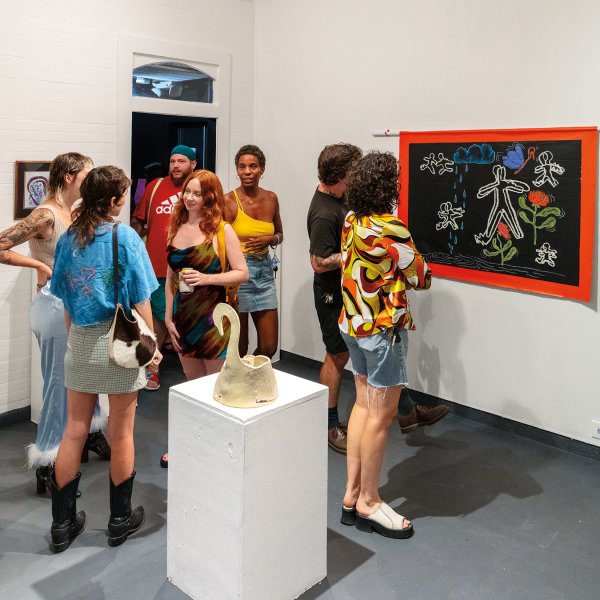
Patrons gather for an opening at The Front, a gallery in the St. Claude Arts District. Photo by Cedric Angeles.
Because of Mardi Gras, mask making in New Orleans is considered high art. Mask Gallery in the French Quarter, owned by renowned leather mask maker Massud Dalili, has a nice collection.
New Orleans Community Printshop & Darkroom is a collectively run, nonprofit community art space specializing in screen printing, relief printing, and black-and-white darkroom photography.
NOLA DDM is an apparel design, development, and production studio in the Marigny neighborhood that does everything from making patterns to sewing the final product.
A private atelier on Magazine Street, Pollack Glass Studio and Gallery emphasizes lampworked glass techniques. Founder Andrew Pollack teaches and shows his work and that of others.
Every three years, the organizers behind Prospect New Orleans, a recurring civic exhibition, invite artists from all over the world to create projects that are displayed or performed in local venues.
“St. Claude Arts District is a really fun place to see a broad range of New Orleans art,” says Frisbie-Calder. “With some of the more exciting and innovative work in the city, you might step into The Front to find yourself in a world of paper-pulp oil refineries and pipes by Hannah Chalew, or into Antenna Gallery to see Abdi Farah’s large-scale portraits of Black football players sewn out of flags and made lifelike through layers of drawing.” Holdren recommends St. Claude as well, singling out The Front and Good Children Gallery.
Since 1996, Stella Jones Gallery has worked to make African American, contemporary African, and Caribbean fine art accessible to all.
Bars, Clubs, Restaurants
Located in the French Quarter, “Bar Tonique hosts a mixture of tourists and locals for a dark and cozy cocktail,” according to Frisbie-Calder.
“Bayou Road is a hub of Black-owned businesses and a great place to explore,” says Chalew. “There's Addis Nola, a very delicious Ethiopian restaurant; Coco Hut, a Caribbean restaurant; and Froot Orleans, a fresh ‘fruit parlor’ with vegan food. There’s also Pagoda, a lovely café, and Velveteen Lounge, a bar with food, both of which are worker-owned. Leo’s Bread is a fabulous bakery also on the strip.”
d.b.a., a bar and music venue on Frenchmen Street, hosts live music daily.
“Dong Phuong restaurant has my favorite Vietnamese food in the city, and during Carnival their bakery makes a King Cake that brings lines around the block,” says Frisbie-Calder.
Horn’s restaurant in the Marigny neighborhood is owned by ceramist Kappa Horn, who sometimes brings in her creations for the customers to see. “Horn’s is my favorite breakfast spot, with classics as well as more New Orleans–style breakfasts like Waffle Cochon,” says Frisbie-Calder.
Owned by members of the storied Baquet restaurant family, Li’l Dizzy’s Cafe in the Tremé neighborhood serves straightforward Creole-soul breakfasts and lunches.
The music club Maple Leaf Bar, located on Oak Street, opened in 1974 and has operated continually since, featuring local legends as well as up-and-coming trios and bands. Koné counts this among his favorite venues.
“The Mosquito Supper Club is amazing,” says Frisbie-Calder. “Melissa Martin, the chef and owner, created the restaurant to tell visitors about the land loss happening in Louisiana and especially in places like Chauvin, where she is from.”
Nonno’s Cajun Cuisine and Pastries promises “a taste of love with every interaction.” Serving all-day breakfast, homemade pastries, generous po’ boys, and respectably spicy gumbo (don’t even try to add hot sauce while the chef is watching), this small restaurant on Dauphine Street hits the spot.
Tucked into a repurposed storefront built in the 1800s, Snug Harbor Jazz Bistro on Frenchmen Street promises live jazz and regional cooking at reasonable prices.
The Spotted Cat Music Club on Frenchmen Street is known among jazz aficionados the world over for its cozy atmosphere and superior musical offerings. “If you go to catch music at the Spotted Cat,” says Frisbie-Calder, “walk over and check out the goods at the late-night Art Garden,” a nearby art and craft market.



